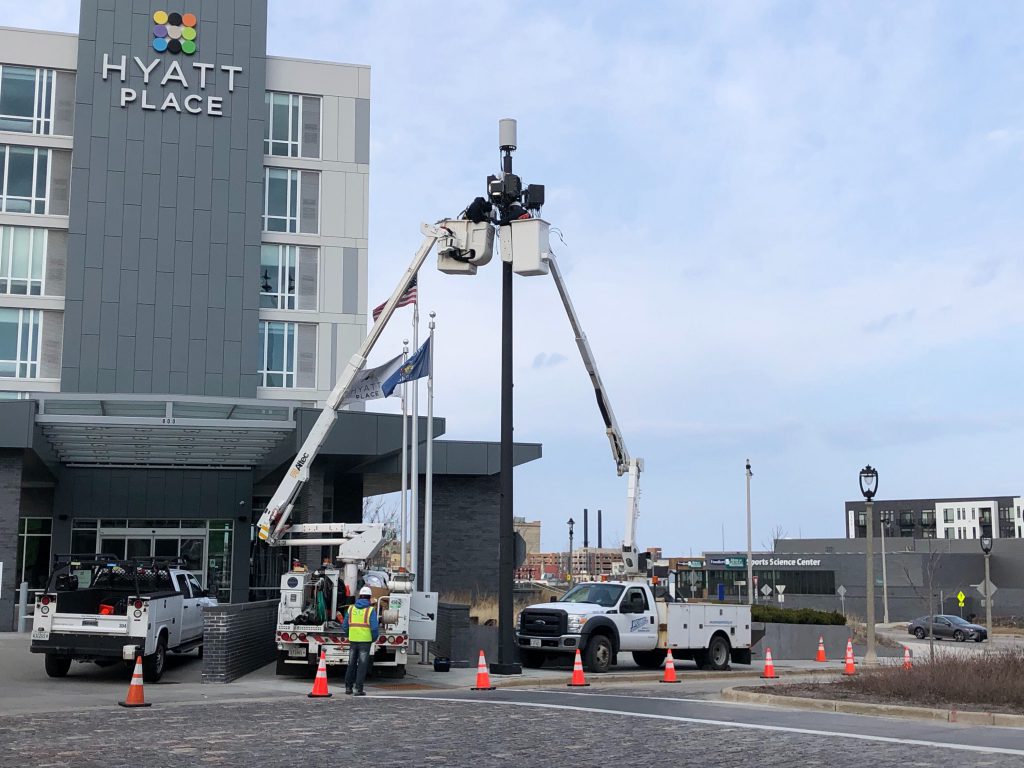Why All The New Cell Phone Towers?
5G towers are popping up across Milwaukee. The city has little power to determine where.

A crew installs 5G cellular equipment atop a utility pole in the Brewery District in April 2020. Photo by Jeramey Jannene.
The cell phone in your pocket is reshaping the urban environment. That could take the form of a new pole in front of your house, and neither you, nor your alderperson, have much control over it.
The buildout of a new, high-speed network known as 5G (for fifth generation) is well underway in Milwaukee. The network will offer speeds many times faster than the current 4G networks, a boon to video streamers, but a vexing problem for city officials.
Work has been underway since 2017 to install the towers around the greater downtown area, and it’s now spreading into more residential areas.
The Department of Public Works has approved or received 1,700 permits in 2020 alone.
“We don’t have a ton of time to look at permits,” said DPW coordination manager Jerrel Kruschke to the Public Works Committee on Wednesday morning.
Moreover, federal and state regulations largely tie the city’s hands with regards to how it can regulate the process. Depending on the type of request the city has between 10 to 90 days to approve it. It isn’t allowed to discriminate with approvals based on the particular provider or to institute a moratorium. Companies must pay permit fees, but can freely place poles in the public right of way, which often includes the land between the curb and sidewalk.
Alderman Jose G. Perez brought up a complaint from his district. A new pole was constructed next to a pocket park while vacant land along the freeway was available a block away.
“When permits come in, we try to direct them to avoid locations like that,” said Kruschke. But he said the city’s authority is limited. “We don’t have the ability to say you have to go two blocks down or three blocks down.”
“I think it’s important that residents know our hands are tied,” Perez said, and “that they have the ability to go directly to the state or companies themselves.”
Kruschke said DPW is working to revise its ordinance to improve the notice requirements. Contractors are required to provide notice to nearby residents and businesses, but disputes have arisen over whether that took place. A new process would create a paper trail. All contractors are required to report to DPW daily on where they are working.
“Where the line gets crossed is where the work is being done on people’s personal property,” said Ald. Mark Borkowski. Kruschke said the city does not permit work on private property and those property owners should raise the issue. The publicly-owned right of way often extends one foot past the high side of the curb, but varies by street, he said.
Even if DPW can convince the companies to co-locate on existing city infrastructure, Trump-appointees on the Federal Communications Commission have struck down some of the benefit. The city previously charged $1,800 annual rent per pole usage, a rate in line with many other large cities. FCC regulations lowered the maximum rate to $270. The FCC said the move will save cell phone providers $2 billion on their $275 billion network buildout.
The city is not alone in its struggles with tower placement. Milwaukee County is grappling with how to deal with towers in parks.
Given that you’re dealing with the visual blight of 5G infrastructure, how can you take advantage of the benefits? You’ll need a new phone and a service plan that includes access to the network. Existing phones, including those from AT&T that say they’re connected to the “5Ge” network, cannot access the new network.
Political Contributions Tracker
Displaying political contributions between people mentioned in this story. Learn more.
- December 13, 2018 - José G. Pérez received $50 from Mark Borkowski
Eyes on Milwaukee
-
Church, Cupid Partner On Affordable Housing
 Dec 4th, 2023 by Jeramey Jannene
Dec 4th, 2023 by Jeramey Jannene
-
Downtown Building Sells For Nearly Twice Its Assessed Value
 Nov 12th, 2023 by Jeramey Jannene
Nov 12th, 2023 by Jeramey Jannene
-
Immigration Office Moving To 310W Building
 Oct 25th, 2023 by Jeramey Jannene
Oct 25th, 2023 by Jeramey Jannene






















The contractors hired to do this work are not the most conscientious. I’ve observed numerous occasions where hazardous conditions were left overnight or over a weekend. This included open holes on sidewalks, shallow excavations left uncovered and/or poorly marked with orange cones or other barriers. Sometimes private property will receive collateral damage from this work.
The wave of installations was just finishing in my neighborhood, then I moved to a neighborhood where this work was just beginning, so I have to endure this a second time!